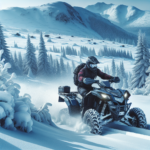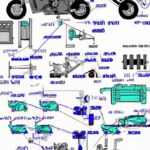You stand at the edge of a snowy road, bundled up and ready for an adrenaline-filled adventure on your snowmobile. As the engine growls under you, you might wonder, “Do snowmobiles have right of way?” Understanding the rules of the icy trail can save you from accidents and conflicts with other outdoor enthusiasts. This article is designed to answer that question and get you ready for the safer riding, exploring the ins and outs of right-of-way regulations for snowmobiles. Remember, safety first!
Understanding Right Of Way
Before you ride your snowmobile down those winding trails, you need to have a clear understanding of right of way. It’s the key to a smooth, safe ride. Let’s break it down for you.
Definition of Right Of Way
Right of way refers to legal access to pass through a determined path or course. Simply put, it’s about who has the legal right to go first when two (or more) are coming from different directions. It keeps things orderly, safe, and predictable to avoid accidents.
How Right Of Way works
Right of way works by certain rules and guidelines set by any governing traffic authority. It tells you, the operator, when you have the right to proceed with caution through an intersection, overtake another vehicle, or pass through a confined area. And just because you have the right of way, doesn’t mean you’re free to speed through sans vigilance. It’s your responsibility to exercise this right safely and responsibly.
The Basics of Snowmobile Operations
Operating a snowmobile isn’t as daunting as it seems when you get the basics.
Basic operations of a snowmobile
A snowmobile operates using a two-stroke or four-stroke engine, which powers both the tracks and the skis. Your hands work the handlebar to steer, while your feet have the task of controlling the brake and throttle. The key? Balance. It may feel a little tricky at first, but with practice, you’ll get the hang of it. Trust us.
Understanding Snowmobile Control Systems
The control systems of a snowmobile include the throttle, brake, handlebars, and start/stop switches. The throttle is usually on the right side, the brake on the left. Master these controls and you’ll have the ability to maneuver your snowmobile like a pro.
Safety guidelines for operating snowmobiles
Safety first, always. Each rider should wear protective clothing (read: helmet, goggles, gloves), maintain a safe speed, not ride alone, and avoid icy bodies of water. Oh, and stay sober. Alcohol and snowmobiling? A big no-no.
Rules And Regulations Governing Snowmobiles
Just like any other vehicles, snowmobiles are governed by rules.
General snowmobile rules
These include guidelines on registration, trail usage, age restrictions, and legal operation hours, among others. Snowmobiles should always be registered and insured. They should only be operated on designated trails and during lawful time periods.
Local and state snowmobile regulations
These can vary depending on your location. It’s vital to be aware of local laws and obedience is key. Weight restrictions, noise pollution controls, and trespass notifications are just some aspects your region may regulate.
Federal laws on snowmobile operation
In addition to local jurisdictions, there are also federal laws and codes to observe. These pertain to national forests and park areas where snowmobiling is allowed under specific provisions.
Rights and Duties of Snowmobile Operators
Operating a snowmobile comes with rights and duties.
Responsibilities of snowmobile riders
Riders have an obligation to operate safely and responsibly. They must comply with all rules, regulations, and common courtesies.
Rights of snowmobile operators
Operators have the right to use designated trails and to demand safe practices from others. It is also their right to be respected by fellow snowmobilers and road users.
How these duties impact the right of way
Adherence to your responsibilities determines your safety and that of others. Disregarding the right of way could lead to accidents and even legal trouble.
Case Scenarios: Do Snowmobiles Have Right Of Way?
Right of way isn’t absolute; it changes based on context.
In highways and public roads
Snowmobiles generally do not have the right of way on highways and public roads. Be cognizant of other vehicles.
In pedestrian paths and trails
Snowmobiles must yield to pedestrians in most cases. Paths and trails are for everyone to enjoy.
Across bodies of water
Water bodies can be tricky. Always check local regulations. And if it’s frozen? Stay away.
Right of Way: Snowmobiles vs. Other Vehicles
Let’s see how right of way is applied with other vehicles.
Snowmobiles vs. cars
Cars generally have the right of way unless otherwise indicated.
Snowmobiles vs. cycled and motorcycles
In many cases, snowmobiles need to yield to smaller, less predictable vehicles like bicycles and motorcycles.
Snowmobiles vs. pedestrians
Pedestrians usually have the right of way. Your snowmobile is faster and bigger; steer clear of foot traffic.
Understanding Snowmobile Accidents and Right of Way
Accidents can happen when we ignore right of way.
Common causes of snowmobile accidents
Excessive speed, reckless driving, and right of way neglect are frequent accident causes.
How right of way violations lead to accidents
Violations can cause confusion, miscalculation, and eventually, accidents.
Legal ramifications of right of way violations
Violations can lead to penalties, revoked licenses or even legal suits.
Legal Aspects Around Snowmobile Right Of Way
Legally, there’s a lot at stake when considering right of way.
Laws surrounding snowmobile right of way
These are in place to ensure safety and prevent accidents. Compliance is non-negotiable.
Legal procedures in the event of a right of way dispute
In case of a dispute, the case may have to go through legal channels.
Penalties for right of way violations
These can range from fines to legal actions depending on the severity of the violation.
Promoting Safe Snowmobiling Conduct
Promoting safe conduct cannot be overstated.
Importance of understanding right of way
Understanding right of way ensures your safety and that of others.
How to teach right of way to new snowmobile operators
It starts with respecting the rules, undergoing proper training, and continuous learning.
Promoting right-of-way awareness in communities
Snowmobile clubs and associations can spearhead community awareness programs.
Conclusion: The Importance of Right Of Way Awareness
Let’s wrap this up, shall we?
Summarizing the importance of right of way
Right of way is essential for a safe, enjoyable snowmobiling experience. It’s not just about respecting the rules. It’s about respecting other people and yourself.
Reiterating the consequences of neglecting right of way rules
Neglect leads to accidents, legal trouble, and more unhealthy consequences.
The role of every snowmobile operator in maintaining safety
Everyone has a part to play. Every operator, new or seasoned, has a responsibility to ensure safety on the trails. And it starts with understanding and respecting the right of way.
- What Snowboard Bindings Should I Get? - January 23, 2024
- What Size Screws For Snowboard Bindings? - January 23, 2024
- How To Snowmobile On Water? - January 23, 2024










